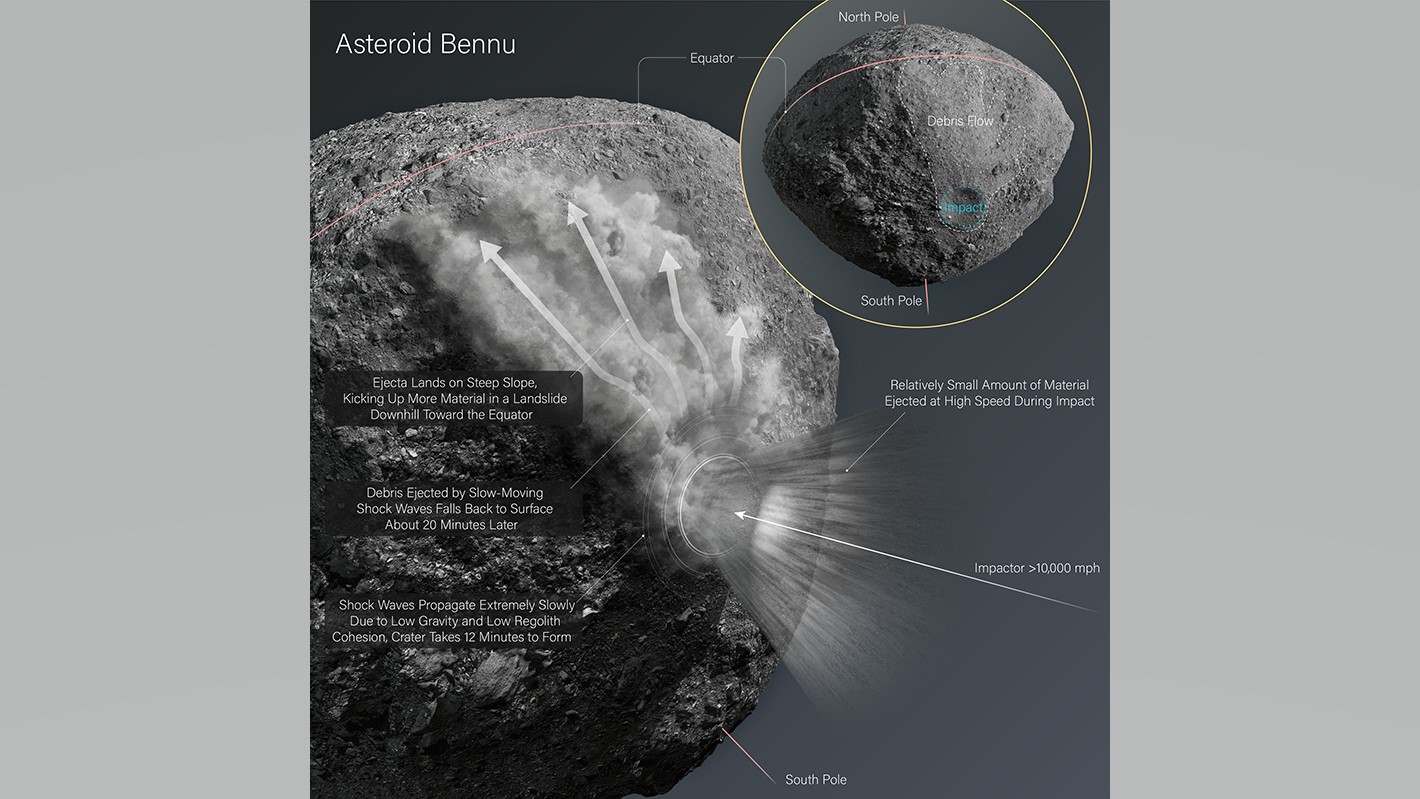Asteroid Bennu sports landslide and massive crater from tiny space rock
The impact of a tiny body on the asteroid Bennu caused a rock slide that revealed the surface properties of rock-pile asteroids.

Using images collected by NASA's OSIRIS-REx spacecraft, researchers have traced the progress of a landslide on the asteroid Bennu that resulted from an impact with another object.
The team determined that the way this "deep-space landslide" progressed would be possible only if Bennu had certain properties at its surface — namely, dry dust particles with little or no cohesion. The discovery gives scientists better insight into how rubble-pile asteroids — those composed of a loose collection of smaller rocks and dust and held together by gravity — take a hit.
"The landslide started when debris from a meteoroid impact fell back onto Bennu's surface," Mark Perry, a researcher at the Johns Hopkins University Applied Physics Laboratory (APL) who led the research, said in a statement. "And when an object hits a surface that hard — from 5 to 20 kilometers per second [3 to 12 miles per second] — you expect the material on the surface to flash up at an equally high velocity. If the object you hit is loosely packed, the material goes up at a lower velocity.
Related: Ride shotgun with NASA's OSIRIS-REx asteroid probe as it buzzes Bennu (video)
"In either case, we'd expect most of the material to jump off into space, but that's not what happened during this impact," Perry said.
The team discovered that the material, or ejecta, returned to the surface of the asteroid and slid down its face. This triggered an avalanche that slowly rolled to the equator of Bennu. Perry pointed out that this could happen on this relatively small object, measuring 1,610 feet (490 meters) in diameter, with its low gravity if the dust that covered it had almost no cohesion.
'Because Bennu is so small, its escape velocity is less than a few tenths of a mile per hour, so any particle ejected faster than that would leave the surface," Perry said. "These slow speeds are possible only if Bennu's surface is weaker than we thought, even weaker than very loose, dry sand. This extremely low surface strength also means the material on a slope is easily disturbed, and that's what led to the landslide."
Get the Space.com Newsletter
Breaking space news, the latest updates on rocket launches, skywatching events and more!

This lack of surface strength was also revealed by another finding: Although the body that struck Bennu was no more than 20 inches (50 centimeters) in diameter, it created a crater that was 230 feet (70 m) wide.
Previous research conducted by the APL had revealed step-like structures called terraces” across Bennu , pointing in an east-west direction, that seemed to result from widespread rock sliding. Again, this surface "creep" could also happen only if Bennu's surface material was loosely bound.
The team estimates that the surface strength of Bennu is weaker than that of other larger asteroids and that of the moon by a factor of least 10,000, which is in line with estimates of the surface strength of other rubble-pile asteroids, such as Ryugu.
"The opportunity to see and study the effects of impacts on Bennu's surface is critical to our understanding of rubble-pile asteroids," Perry said. "The more we learn about the evolution, composition, and structure of these fascinating objects, the more insight we gain into the role they played in forming the solar system we know today and that they could play in future exploration of worlds beyond our own."
The team's findings ware published May 23 in the journal Nature Geoscience.
Follow us on Twitter @Spacedotcom or on Facebook.
Join our Space Forums to keep talking space on the latest missions, night sky and more! And if you have a news tip, correction or comment, let us know at: community@space.com.

Robert Lea is a science journalist in the U.K. whose articles have been published in Physics World, New Scientist, Astronomy Magazine, All About Space, Newsweek and ZME Science. He also writes about science communication for Elsevier and the European Journal of Physics. Rob holds a bachelor of science degree in physics and astronomy from the U.K.’s Open University. Follow him on Twitter @sciencef1rst.








